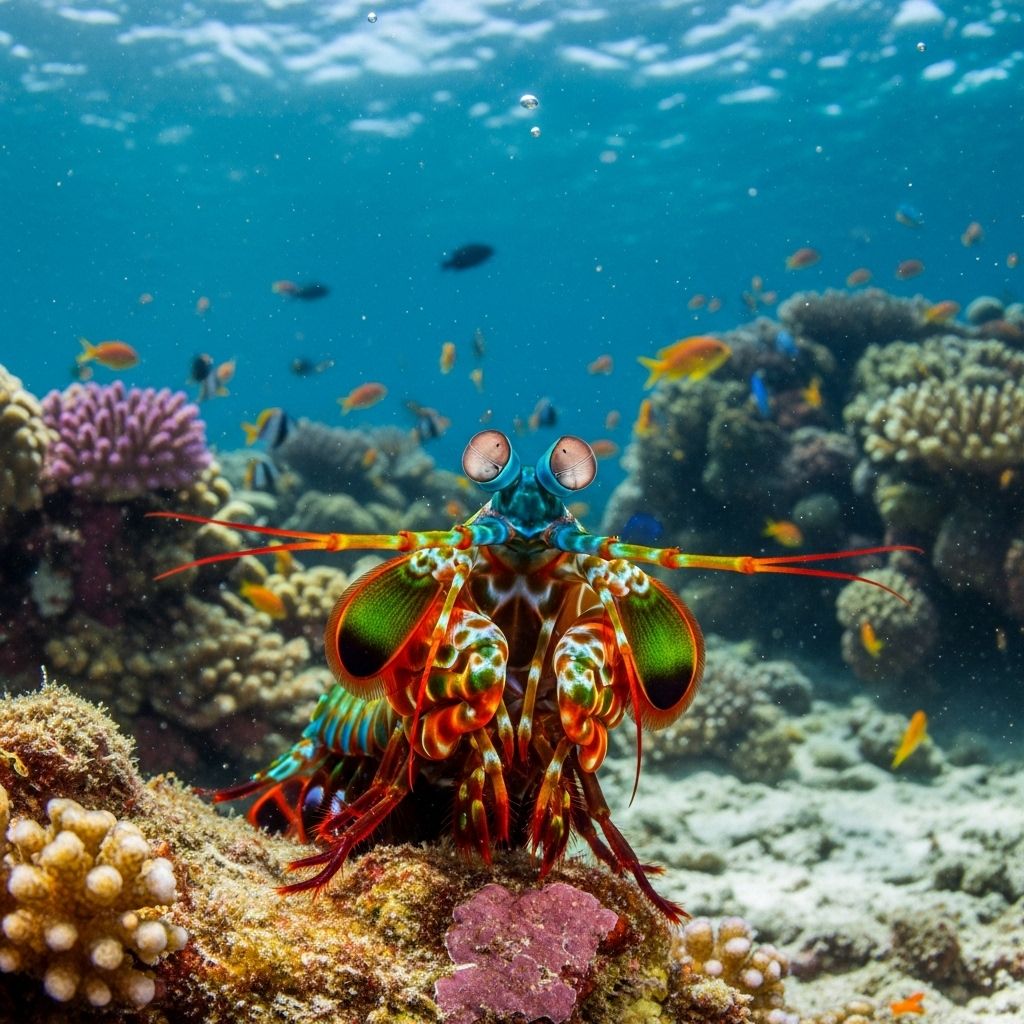Mantis Shrimp: The Vibrant and Powerful Predators of the Sea
Explosive strikes and spectrum-shifting vision redefine how we see marine marvels.

Image: HearthJunction Design Team
The mantis shrimp is a marine crustacean famed for its dazzling color palette and thunderous hunting capabilities. Revered as one of the ocean’s most remarkable predators, mantis shrimp possess physical and behavioral traits that continue to astound scientists, aquarists, and nature lovers alike. This article explores every fascinating facet of the mantis shrimp, from its striking appearance and kinds to its hunting prowess, unique vision, care in captivity, and much more.
Overview of Mantis Shrimp
Mantis shrimp are neither true shrimp nor mantises but belong to the order Stomatopoda, an ancient crustacean lineage with around 450 to 500 known species. Found primarily in the warm, shallow waters of the Indian and Pacific Oceans, these creatures are relics of evolutionary innovation, exemplifying nature’s creativity in form and function.
- Common Lengths: 2 to 15 inches depending on species (most 4–8 inches)
- Lifespan: Typically 3–6 years; some species can exceed 20 years
- Conservation Status: Not endangered; populations appear stable
- Range: Indian & Pacific Oceans, extending from Eastern Africa to Hawaii
Appearance and Anatomy
Few marine creatures rival the mantis shrimp’s burst of color. Their shells display vivid hues including emerald green, brilliant blue, fiery red, and lush orange. Species like the peacock mantis shrimp (Odontodactylus scyllarus) are particularly renowned for these flamboyant patterns and spots covering their robust, segmented bodies.
- Eyes: Large, stalked, and emerald-colored; highly mobile and independently rotating
- Carapace: Covers the rear head and first four thoracic segments
- Appendages: Raptorial claws that fold beneath the body, adapted for powerful hunting
- Walking Legs: Multiple pairs for movement and handling prey
Kinds of Mantis Shrimp: Smashers and Spearers
Mantis shrimp are classified by their specialized hunting appendages and foraging strategies:
- Smashers: Wield club-shaped appendages reinforced with mineralized layers, capable of delivering shockwaves that break hard shells and even aquarium glass. The peacock mantis shrimp is the most famous smasher, using its clubs to obliterate gastropods, mollusks, crabs, and more.
- Spearers: Feature sharp, spiny appendages resembling a praying mantis’ claw. They lie in wait and impale soft-bodied prey such as fish with lightning speed. Some species grow much larger, with spearers like the giant mantis shrimp (Lysiosquillina lisa) reaching lengths up to 13 inches or more.
Notable Types and Species
| Common Name | Scientific Name | Type | Notable Traits |
|---|---|---|---|
| Peacock Mantis Shrimp | Odontodactylus scyllarus | Smasher | Bright colors, powerful clubs, popular in aquariums |
| Giant Mantis Shrimp | Lysiosquillina lisa | Spearer | Largest species, up to 13 in, burrowing behavior |
| Pink-eared Mantis Shrimp | Odontodactylus latirostris | Smasher | Aggressive, territorial, distinctive red/white appendages |
| Shortnose Mantis Shrimp | Odontodactylus brevirostris | Smasher | Diurnal, territorial, rapid strikes |
Distribution and Habitat
Mantis shrimp inhabit tropical and subtropical coastal regions, favoring reefs, seagrass beds, and sandy or muddy flats:
- Warm, shallow marine environments, predominantly in the Indian and Pacific Oceans
- Range extends from Eastern Africa to Hawaii
- Burrows into sand, mud, or within rocky crevices for protection and ambush hunting
Feeding Behavior and Diet
The mantis shrimp is an apex predator of its scale. Its hunting is defined by speed, precision, and violence. Using specialized claws, they deliver an explosive punch or impale prey in a fraction of a second, with smasher species generating force comparable to a bullet.
- Diet: Marine snails, crabs, mollusks, shrimp, fish, and occasionally other mantis shrimp
- Prey Capture: Strikes up to 50 times faster than the blink of an eye (approx. 23 m/s), creating enough force to shatter shells
- Top Speed: Can reach 30 body lengths per second
Sensory Abilities and Vision
Among all animals, mantis shrimp display some of the world’s most complex eyes. Their large, independently moving stalked eyes give exceptional depth perception and a wide visual field.
- Each eye contains at least 12 photoreceptor types for color—humans have only 3—for an extraordinary spectrum of color vision and ultraviolet detection.
- Three-part division (trinocular vision in each eye) enhances depth perception even if one eye is injured.
- Capable of seeing polarized light; can decode light information invisible to most other animals.
- Ongoing research into mantis shrimp vision inspires innovations in camera and optics technology.
Behavior and Social Life
Mantis shrimp are typically solitary and highly territorial. Many species spend much of their time hidden in burrows, emerging to hunt or mate. They vigorously defend their territory, and violent intraspecific confrontations are common, particularly among individuals of the same gender.
- Burrowers: Most species invest significant energy in constructing and maintaining their burrows.
- Diurnal or nocturnal habits vary by species.
- Courtship involves complex rituals, displays, and sometimes extended pair bonds for certain species.
Predators and Defensive Strategies
Despite their formidable arsenal, mantis shrimp have natural predators. Larger fish such as tuna, as well as some humans, will prey on mantis shrimp. Their best defense is their ability to quickly retreat into burrows and, when required, fight back fiercely with their powerful weapons.
- Known Predators: Large fish (yellowfin tuna), humans, octopuses
- Escape Tactics: Quick burrow retreats; aggressive defense using claws
Life Span and Reproduction
The average life expectancy of mantis shrimp in the wild is 3 to 6 years, but certain captive individuals have surpassed 20 years. Courtship and breeding behaviors are highly species-dependent.
- Some form monogamous, long-term pair bonds, sharing burrows and tending to eggs together.
- Eggs are either kept in burrows or carried by the female on her forelimbs until they hatch.
Scientific and Human Importance
The mantis shrimp’s unique physiology is of substantial interest to science and engineering:
- Biomimicry: The design of their club appendages, which withstand repeated high-velocity impacts, inspires research for advanced body armor and aerospace materials.
- Optics Research: Their sophisticated eyes guide breakthroughs in high-resolution cameras and polarization sensors.
- Medical Studies: Investigation into their vision may someday help treat human visual disorders.
Mantis Shrimp in Aquariums
Although beautiful and fascinating to watch, mantis shrimp are considered challenging pets best suited to advanced marine aquarists. Their strength and aggression require secure, species-specific housing and careful management.
- Tank Setup: A solitary tank with thick glass (ideally acrylic for smashers) and plentiful hiding spots is essential.
- Diet: Frozen shrimp, shellfish, and live prey as enrichment; a varied diet matches their wild nutrition.
- Compatibility: Should not be housed with most fish, crustaceans, or invertebrates due to predation risk.
- Water Conditions: Stable marine parameters; frequent partial water changes and strong filtration are necessary.
Responsible Aquarium Care Tips
- Ensure the enclosure is well-anchored and features multiple caves or burrow tubes.
- Check for signs of stress or injury, particularly if keeping larger species.
- Do not attempt hand-feeding due to the risk of injury from their powerful claws.
- Research the specific needs and maximum size of any mantis shrimp species before purchase.
Frequently Asked Questions (FAQs)
What is the most colorful mantis shrimp species?
The peacock mantis shrimp (Odontodactylus scyllarus) is considered the most colorful, showcasing a dazzling array of reds, greens, blues, and oranges.
How strong is a mantis shrimp punch?
Smasher-type mantis shrimp can deliver strikes with forces exceeding 1,500 newtons—fast enough to break glass, shatter shells, and even stun prey with shockwaves.
Can mantis shrimp see more colors than humans?
Yes, mantis shrimp possess at least twelve types of color receptors in their eyes (humans have three), enabling them to perceive a vastly broader spectrum of colors and polarized light.
Are mantis shrimp dangerous to humans?
While not aggressive toward humans, mantis shrimp can cause painful injuries with their powerful claws if handled improperly. Handle only with proper equipment or leave undisturbed in the wild or tank.
How long do mantis shrimp live?
The typical lifespan is 3–6 years in the wild, but some individuals may live up to or over 20 years, especially in captivity where threats are minimized.
Do mantis shrimp make good aquarium pets?
They offer mesmerizing beauty and behavior but are best suited to experienced aquarists due to their aggression, strength, and specialized care needs.
Key Takeaways
- Mantis shrimp blend breathtaking colors with evolutionary ferocity, possessing one of nature’s top predatory armaments.
- Their visual system surpasses almost every other animal, and their striking speed and force are unequaled in the marine world.
- Care in captivity demands respect for their natural behaviors, secure tank conditions, and an understanding of their solitary, predatory nature.
From the vibrant reefs of the Indo-Pacific to the aquariums of advanced enthusiasts, the mantis shrimp stands as an emblem of the ocean’s beauty and evolutionary marvels.
References
Read full bio of Srija Burman












